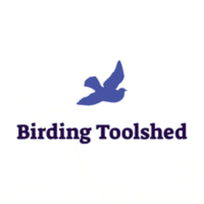Best Bird Feeders for Different Bird Species: Top Choices for Every Backyard Bird
Looking to attract a variety of birds to your backyard? In this guide, we’ve rounded up the Best Bird Feeders for Different Bird Species, so you can choose the perfect setup for cardinals, finches, woodpeckers, hummingbirds, and more. Whether you’re a beginner or a seasoned birder, learn which feeder types work best for specific birds—and how to make your backyard a birdwatching paradise
5/19/20257 min read
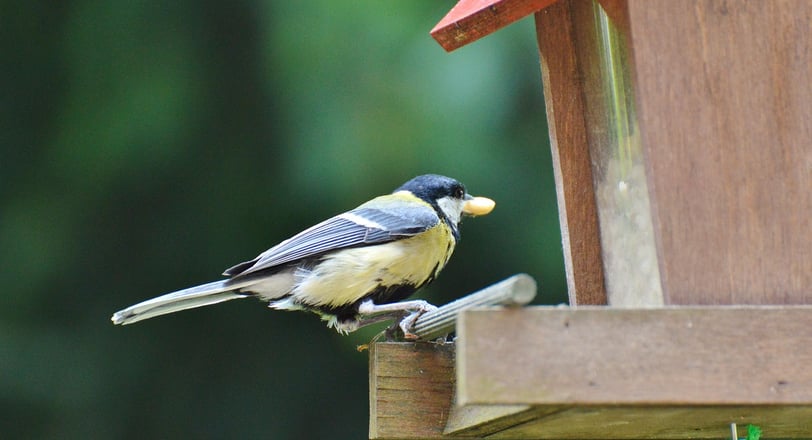

The best bird feeder for your backyard depends on the types of birds you want to attract. Different species, like finches, cardinals, or woodpeckers, have unique needs and feeder preferences. Picking the right feeder can help you see more colorful and interesting birds right outside your window.
Some feeders work better for small birds that like seeds, while others can handle larger birds or special foods like suet. The right feeder can also help keep out unwanted pests or squirrels. Knowing your local birds is important when deciding which feeder to buy.
Key Takeaways
Choosing feeders depends on the birds you want to attract.
Features and food types matter for different species.
Clean, well-kept feeders bring healthier birds.
Factors to Consider When Choosing Bird Feeders
Selecting the right bird feeder depends on the species you want to attract, feeder design, and where you place it. The best feeder keeps birds safe while making it easy for you to fill and clean.
Selecting the right bird feeder depends on the species you want to attract, feeder design, and where you place it. The best feeder keeps birds safe while making it easy for you to fill and clean.
Bird Species Preferences
Different birds look for different food and feeder types. Small birds like finches and chickadees prefer tube feeders with small ports. Cardinals and grosbeaks need larger perches and can use hopper or tray feeders.
Woodpeckers and nuthatches like suet feeders, which often have cages or baskets. Hummingbirds use feeders made for nectar, with tiny ports to prevent bees and wasps from getting in.
Common Bird Species and Their Feeder Preferences:
Choose based on the birds in your area. If you want many kinds of birds, use different feeder types to suit their needs.
Feeder Types and Materials
Feeders are made in different shapes and from a range of materials. Tube feeders are great for small seeds and keep food dry. Hopper feeders hold a lot of seed and are easy to refill. Tray or platform feeders attract many species but can get dirty quickly and let seeds get wet.
Materials matter, too. Metal and sturdy plastics last longer and resist damage from squirrels or weather. Wood feeders look nice but need more cleaning and care. Make sure any feeder can be taken apart easily for cleaning, since mold and old food can make birds sick.
Good feeders have drainage to keep seeds dry. Avoid feeders with sharp edges, weak parts, or places where birds can get stuck.
Feeder Placement for Safety
Where the feeder sits can protect birds from predators and accidents. Feeders should be at least 10 feet away from dense bushes or hiding spots for cats. Keep feeders 3 feet or closer to windows, or over 30 feet away, to cut down on window collisions.
Hang feeders high enough to keep squirrels and other animals from reaching them. Use baffles or guards if needed. Place feeders where you can see them but still in a quiet area, so birds feel safe eating.
Regularly check that the area under the feeder stays clean. Too much dropped seed can attract pests or cause disease. Place feeders so you can reach them easily for cleaning and refilling.
Top Bird Feeders by Species
Different birds have specific needs when it comes to feeders, seed types, and placement. Using the right feeder can help attract the species you want and keep them safe while they eat.
Feeders for Finches
Finches, such as goldfinches and house finches, like to eat tiny seeds, especially nyjer (thistle) and sunflower chips. They do best with tube feeders that have small feeding ports. These feeders should have perches that are just big enough for finches, making it harder for larger birds to take over.
Mesh sock feeders are also popular for finches because their fine holes let finches cling and eat easily. Place the feeder in an open area, but away from heavy traffic. Make sure it's easy to clean because finches are sensitive to moldy or wet seed.
Recommended Features:
Tube design with small ports
Mesh or sock style for clinging
Holds nyjer or finely chipped sunflower seed
Easy to refill and clean
Feeders for Cardinals
Cardinals prefer feeders where they can perch comfortably. They have large bodies and thick beaks, so they need bigger perches and open tray or platform feeders. Look for sturdy feeders with broad, stable surfaces.
Cardinals like black oil sunflower seeds the most and often reject most mixes with fillers. Hopper feeders with strong ledges or large tray feeders are a good choice. Place feeders near shrubs or trees to provide cover, since cardinals are shy and like to eat where they feel safe.
Key Tips for Cardinal Feeders:
Use large, strong perches or trays
Choose feeders with weather protection
Fill with black oil sunflower seeds
Place near natural cover
Feeders for Woodpeckers
Woodpeckers are attracted to suet, peanuts, and sometimes sunflower seeds. The best way to feed woodpeckers is with a suet feeder that has a tail prop extension, which helps them balance while they eat.
Caged suet feeders prevent larger birds or squirrels from stealing the food. Mount suet feeders on trees or sturdy poles in a quiet, shady spot. Some woodpeckers also use peanut feeders—wire mesh tubes that hold whole or shelled peanuts.
Tips for Woodpecker Feeders:
Use suet cages with tail props
Hang feeders vertically on trees or poles
Offer plain suet or peanut-based suet cakes
Place feeders in shady locations
Feeders for Hummingbirds
Hummingbirds feed on nectar, not seeds. Use a bright red nectar feeder made from a safe, easy-clean material like glass or sturdy plastic. Many feeders have several small feeding ports with bee guards to keep insects out.
Always fill feeders with a homemade solution of four parts water to one part white sugar. Never use honey or artificial colors. Clean the feeders every few days to prevent mold, especially in hot weather. Hang feeders in partial sunlight, out of strong wind, and near flowers if possible.
Best Practices for Hummingbird Feeders:
Use red feeders with ant moats and bee guards
Offer only sugar water (no dyes)
Clean and refill at least twice a week
Place near flowering plants or shrubs
Specialized Bird Feeder Features
Bird feeders come with unique features to solve common problems like squirrels, cleaning hassles, and outdoor weather. Choosing the right features can improve your feeding setup and attract more birds.
Squirrel-Proof Designs
Squirrels often raid feeders, eating birdseed and scaring away birds. Squirrel-proof feeders use special mechanisms to stop them. Many have weight-sensitive perches that close access when heavier animals land on them. Others use sturdy metal cages around the seed area.
Top squirrel-proof features:
Spring-loaded closing ports
Metal cages
Baffled domes
A squirrel baffle, shaped like a dome, often keeps squirrels from climbing down onto the feeder. It is important that these designs only block squirrels and not small birds. People who live in squirrel-heavy areas prefer metal feeders because squirrels can sometimes bite through plastic.
Easy-to-Clean Feeders
Feeders need regular cleaning to stop mold, germs, and old seed from building up. This keeps birds healthy. Some feeders are easy to take apart for quick cleaning. Look for wide openings and simple parts that twist or snap off.
Benefits of easy-to-clean feeders:
Less chance of spreading disease
Faster, simpler cleaning process
Fewer places for old seed to hide
Good designs include smooth, non-porous surfaces and no tight corners. Tube feeders with removable bottoms, and hopper feeders that open wide at the top, make rinsing easier. Being able to scrub all surfaces, inside and out, helps keep the feeder safe for birds.
Weather-Resistant Options
Outdoor feeders are exposed to wind, rain, and sun. Weather-resistant feeders use tough materials like powder-coated metal or UV-stabilized plastic. These materials last longer and protect birdseed from moisture.
Feeder weather-resistant features:
Tight-fitting lids to keep rain out
Drainage holes at the bottom so water cannot pool
Rust-proof metal parts
Some weatherproof models have roofs or covers that shield seeds from direct rain and snow. Feeders with strong seals also guard against seed getting soggy and spoiled. Weather-resistant feeders are usually easier to maintain and stay looking new longer even in harsh conditions.
Maintaining and Cleaning Bird Feeders
Keeping bird feeders clean is important to protect birds from disease. Dirty feeders can spread bacteria and mold. Regular cleaning helps keep birds safe and healthy.
Steps for Cleaning Bird Feeders:
Take down the feeder and empty old seeds.
Soak the feeder in a mix of hot water and mild dish soap.
Use a brush to scrub all surfaces, including small openings.
Rinse well with clean water.
Let the feeder dry completely before refilling with bird seed.
It is best to clean feeders at least once every two weeks. In very wet or hot weather, feeders may need cleaning once a week.
Signs a feeder needs cleaning:
Moldy or clumped seed
Sticky or foul smell
Visible dirt or droppings
Type of Feeder Recommended Cleaning Frequency
Tube Feeder Every 2 weeks
Platform Feeder Weekly
Suet Feeder Every 1-2 weeks
Hummingbird Feeder Every 3-5 days
Wearing gloves can help protect from bacteria. Avoid using harsh chemicals or bleach that might harm birds. A simple brush and warm soapy water is usually enough for most feeders.
Checking feeders for damage, rust, or sharp edges is also important. Broken parts can injure birds and should be repaired or replaced.
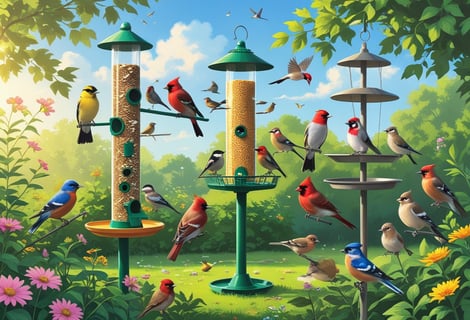

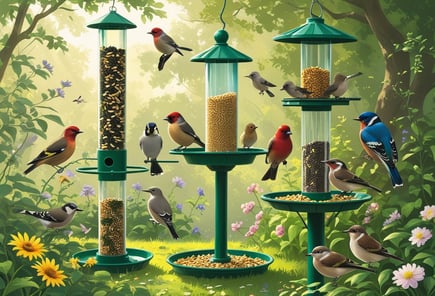

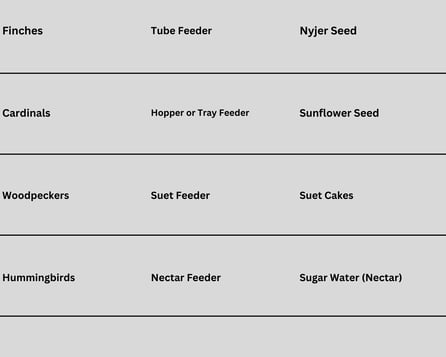









Gear
Quality reviews to enhance your birdwatching experience.
Guide
© 2025. All rights reserved.
